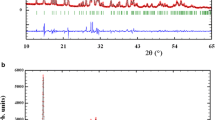Abstract
Microscopic structures and mechanical properties of amorphous TiO2 ultra-fine particles have been studied by positron annihilation spectroscopy. A positron lifetime of about 1.5 ns was found as the longest lifetime component τ3 which is attributed to the ortho-positronium annihilation in open space. The lifetime τ3 and the corresponding intensity I3 was independent of atmosphere: vacuum and various gasses. Accordingly, a micro-void is contained inside the particle as the open space. An intermediate lifetime τ2 was approximately 0.4 ns. The intensity I2 was strongly affected by the atmosphere. No effect was found for the particles, the surface of which was coated by silicon dioxide film. This component is arisen from the positron annihilation on the particle surface and the particles contain the surface cracks. When the volume of particles packed in an ampoule was decreased by 1/4 times by compression, the longest component as well as the intermediate one disappeared and only the shortest-lifetime component τ1 of about 0.24 ns remained. To conclude, the particles are so soft that the micro-voids and the surface cracks are collapsed by compression.
Similar content being viewed by others
References
Y. C. Jean, K. Venkateswaren, X. H. Luo and K. L. Cheng, in “Positron Annihilation,” edited byL. Dorikens, M. Dorikens and D. Segers (World Scientific, Singapore, 1989) p. 567.
L. Y. Xion, W. Deng, J. Zhu, A. Dupasquier, X. J. Wu and X. L. Ji, Mater. Sci. Forum 577 (1993) 175–178.
R. W. Siegel, S. Ramasamy, H. Hahn, Z. Li and T. Lu, J. Mater. Res. 3 (1988) 1367.
J. Karch, R. Birringer and H. Gleiter, Nature 330 (1987) 556.
R. WÜrschum, W. Greiner, G. Soyez and H.-E. Schaefer, Mater. Sci. Forum 105-110 (1992) 1337.
P. Kirkgaard, N. J. Pedersen and M. Eldrup,Risø M-2740 (1988).
S. Tanigawa, K. Hinode, N. Owada, M. Doyama, E. Iguchi and A. Inoue, in “Proceedings of 5th International Conference on Positron Annihilation,” edited byR. R. Hasiguti and K. Fujiwara (The Japan Institute of Metals,Sendai, 1979) p. 475.
S. J. Tao, J. Chem. Phys. 56 (1972) 5499
M. Eldrup, D. Lightbody and J. N. Sherwood, Chem. Phys. 63 (1981) 51.
Author information
Authors and Affiliations
Rights and permissions
About this article
Cite this article
Murakami, H., Onizuka, N., Sasaki, J. et al. Ultra-fine particles of amorphous TiO2 studied by means of positron annihilation spectroscopy. Journal of Materials Science 33, 5811–5814 (1998). https://doi.org/10.1023/A:1004450015173
Issue Date:
DOI: https://doi.org/10.1023/A:1004450015173



